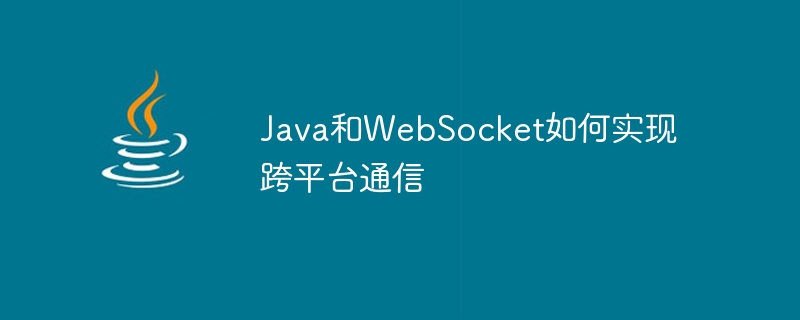Home >Java >javaTutorial >How Java and WebSocket enable cross-platform communication
How Java and WebSocket enable cross-platform communication
- WBOYWBOYWBOYWBOYWBOYWBOYWBOYWBOYWBOYWBOYWBOYWBOYWBOriginal
- 2023-12-18 08:13:211206browse

How Java and WebSocket achieve cross-platform communication
With the rapid development of the Internet and the popularity of mobile applications, communication between different platforms has become a very important needs. As a general-purpose language, Java has a wide range of application scenarios, and WebSocket, as a real-time communication protocol, can establish persistent, full-duplex connections between different platforms, making it a very suitable technology for cross-platform communication.
This article will introduce how to use Java and WebSocket to achieve cross-platform communication and give specific code examples.
1. Introduction to WebSocket
The WebSocket protocol is part of HTML5 and provides a method for real-time two-way communication between a web browser and a server. Different from the traditional HTTP request-response model, WebSocket uses a long connection built on TCP, allowing the server to actively send messages to the client.
2. How Java implements WebSocket
- Use native Java API
Java provides the javax.websocket package to support WebSocket. We can write a WebSocket endpoint class, implement the Endpoint interface, and override its methods to handle WebSocket communication.
@ServerEndpoint("/websocket")
public class MyWebSocket {
@OnOpen
public void onOpen(Session session) {
System.out.println("WebSocket连接已打开");
}
@OnMessage
public void onMessage(String message, Session session) {
System.out.println("收到消息:" + message);
// 处理消息逻辑
}
@OnClose
public void onClose(Session session) {
System.out.println("WebSocket连接已关闭");
}
@OnError
public void onError(Session session, Throwable error) {
System.out.println("WebSocket发生错误:" + error.getMessage());
}
}- Use third-party libraries
In addition to using the native Java API, you can also use third-party libraries to simplify the implementation of WebSocket. For example, using the WebSocket library provided by Jetty can handle WebSocket communication more conveniently.
First, you need to add the dependency of Jetty WebSocket:
<dependency>
<groupId>org.eclipse.jetty.websocket</groupId>
<artifactId>websocket-server</artifactId>
<version>9.4.43.v20210629</version>
</dependency>Then, write a WebSocketHandler class, inherit from the WebSocketHandler provided by Jetty, and override the methods in it.
public class MyWebSocketHandler extends WebSocketHandler {
@Override
public void configure(WebSocketServletFactory factory) {
factory.register(MyWebSocket.class);
}
}Finally, configure the WebSocket path and Handler in the Servlet container.
public class WebSocketServer {
public static void main(String[] args) throws Exception {
Server server = new Server(8080);
WebSocketHandler handler = new MyWebSocketHandler();
ServletContextHandler context = new ServletContextHandler(server, "/");
context.addServlet(DefaultServlet.class, "/");
context.addServlet(WebSocketServlet.class, "/websocket");
context.setHandler(handler);
server.start();
server.join();
}
}3. Cross-platform communication example
Suppose we have a simple platform A and platform B and need to achieve cross-platform communication. Platform A uses Java to implement the WebSocket server, and platform B uses JavaScript to implement the WebSocket client.
- WebSocket server code example for platform A
@ServerEndpoint("/websocket")
public class MyWebSocket {
@OnOpen
public void onOpen(Session session) {
System.out.println("WebSocket连接已打开");
}
@OnMessage
public void onMessage(String message, Session session) {
System.out.println("收到消息:" + message);
try {
session.getBasicRemote().sendText("收到消息:" + message);
} catch (IOException e) {
e.printStackTrace();
}
}
@OnClose
public void onClose(Session session) {
System.out.println("WebSocket连接已关闭");
}
@OnError
public void onError(Session session, Throwable error) {
System.out.println("WebSocket发生错误:" + error.getMessage());
}
}- WebSocket client code example for platform B
var socket = new WebSocket("ws://localhost:8080/websocket");
socket.onopen = function() {
console.log("WebSocket连接已打开");
socket.send("Hello Server!");
};
socket.onmessage = function(event) {
console.log("收到消息:" + event.data);
};
socket.onclose = function(event) {
console.log("WebSocket连接已关闭");
};
socket.onerror = function(event) {
console.log("WebSocket发生错误");
};Through the above Example, we can see that cross-platform communication can be easily achieved using Java and WebSocket. Whether on the server or the client, as long as the platform supports the WebSocket protocol, real-time two-way communication can be achieved. This provides a simple and efficient way to meet the real-time communication needs between different platforms.
Summary:
This article details how to use Java and WebSocket to achieve cross-platform communication, and gives specific code examples. By using Java's native API or third-party libraries, we can easily implement the WebSocket server and client and achieve real-time two-way communication. Whether in desktop applications, mobile applications or web applications, Java and WebSocket can provide an efficient, real-time cross-platform communication solution.
The above is the detailed content of How Java and WebSocket enable cross-platform communication. For more information, please follow other related articles on the PHP Chinese website!

